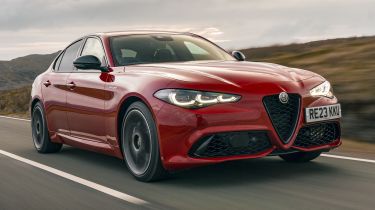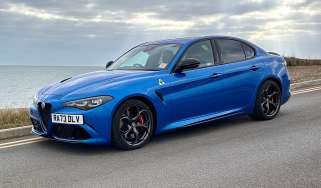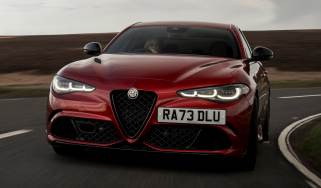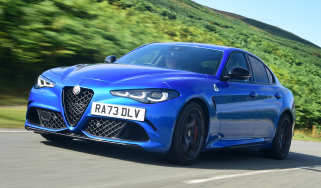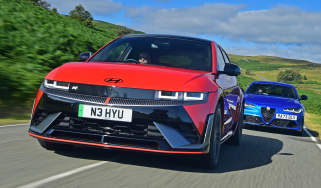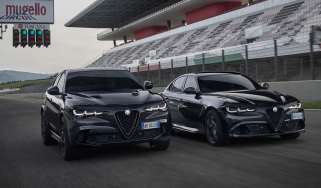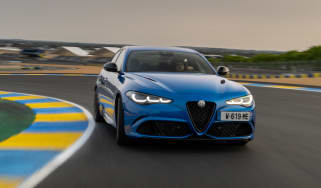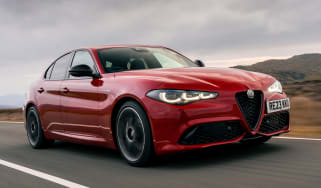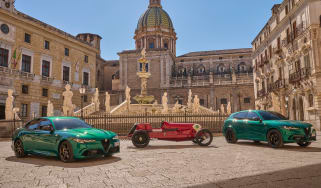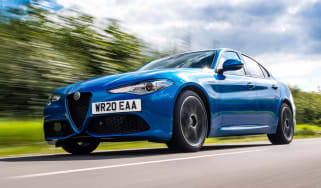Alfa Romeo Giulia review
The Alfa Romeo Giulia is seductively stylish, offering rear-drive thrills and plenty of Italian charm

The Alfa Romeo Giulia could be a superb choice for compact executive saloon car buyers, as it offers a brilliant mix of gorgeous looks, fun handling and decent running costs. Like the Jaguar XE, it’s a welcome alternative to rivals from the German manufacturers, and has a unique character.
The Giulia's petrol engine is excellent, and while it’s a shame we don’t get a manual option here in the UK, the eight-speed automatic gearbox is very good. Fans of Mercedes and Audi interiors might find the Giulia's cabin isn't quite up to the same standards, but there’s so much to like about Alfa’s compact executive saloon that it could still win them over.
About the Alfa Romeo Giulia
Cars like the Alfa Romeo Giulia provide a breath of fresh air in the new car market, as it offers a great alternative to the mainstream executive norm. Alfa's four-door saloon sits in the compact executive saloon sector, with its many rivals including the the BMW 3 Series, which offers great handling and a plush ride, the Mercedes C-Class that puts luxury to the fore and the Audi A4 which is a tech-lovers dream.
Elsewhere in the class, the Jaguar XE has the all-round ability to compete, the Volvo S60 adds a slice of Swedish style and comfort to the mix and the Volkswagen Arteon offers style that means it's knocking at the door of the executive class.
Used - available now

2021 Alfa Romeo
Giulia
26,678 milesAutomaticPetrol2.0L
Cash £24,888
2019 Alfa Romeo
Giulia
47,444 milesAutomaticPetrol2.0L
Cash £21,801
2016 Alfa Romeo
Giulia
61,000 milesAutomaticDiesel2.1L
Cash £16,995
2021 Alfa Romeo
Giulia
34,796 milesAutomaticPetrol2.0L
Cash £25,300Meanwhile, the 503bhp, V6-powered Giulia Quadrifglio is an alternative to fiery models such as the Audi RS 4 Avant, BMW M3 or M4, Lexus RC F and the Mercedes C63, although the latter has now turned to petrol plug-in hybrid power to help it to a mammoth 671bhp.
While its German rivals are offered in a variety of body styles, the Giulia comes solely as a saloon. But what a shape it has, with taut curves and that distinctive shield grille up front, slender lights and a rakish roof, it's easily the head-turner of the class. The Giulia also received some subtle design tweaks in 2023, including a new 3x3 headlight signature and ‘Trilobo’ grille. Inside, the Giulia continues to turn on the style with aluminium shift paddles on the steering column, a 12.3-inch digital dash panel and 8.8-inch central touchscreen. If you're after something a bit more practical, Alfa has the Tonale compact SUV and Stelvio mid-size SUV.
The refreshed Giulia is only available with one engine: a 276bhp 2.0-litre four-cylinder turbocharged petrol engine. The 197bhp version of the same motor was removed from the range in the name of simplification in 2023, and you can no longer get a diesel-powered Giulia either. All Giulias are rear-wheel drive and while European markets have the option of a six-speed manual gearbox, in the UK all models are fitted with an eight-speed automatic transmission.
There are three trim levels to choose from – Sprint, Veloce and Competizione – with prices starting from around £43,000. Standard kit includes 18-inch alloy wheels, Apple CarPlay and Android Auto connectivity, wireless charging pad, reversing camera, cruise control, blind spot monitoring and Autonomous Emergency Braking, among other safety systems.
Engines, performance and drive
The Giulia nameplate has a rich history with roots stretching back to 1962. This four-door executive saloon makes extensive use of lightweight materials, such as carbon fibre for the driveshaft and aluminium for some chassis parts and the bodywork, including the suspension sub frames.
It means Alfa has given the Giulia 50:50 weight distribution, which should make the car great to drive. Double-wishbone suspension takes care of damping at the front, while a multi-link rear set-up means no corners have been cut to deliver great handling.
The first thing you’ll notice after setting off in the Alfa is the quick steering, which feels great through a series of turns. It’s accurate, too, so you can have confidence placing the car where you want it.
The chassis is also sharp, although at first the Giulia can feel nervous and hyper-alert because its steering is that sensitive, particularly in the Dynamic setting. However, once you get used to the rate of response, you learn to use less lock and the Giulia’s reactions feel more natural.
Alfa Romeo’s DNA selector means you can choose from three driving modes in the standard cars: D for Dynamic, N for Natural and A for Advanced Efficiency (the Quadrifoglio also gets a Race mode). These allow you to alter the steering weight and throttle response, but the car feels at its best in the Natural and Dynamic modes, with the 'A' setting taking a bit too much away from the car's responses. It’s not as involving as a BMW 3 Series, but the Giulia serves up enough engagement to keep keen drivers interested.
For the most part the Alfa handles bumps and imperfections well in the Natural setting, or with the adaptive dampers (standard on Competizione models) in their softer mode, but some surfaces and potholes do send a shockwave through the chassis, with some lateral wobble noticeable.
By and large the Giulia offers a decent level of comfort, although it’s clearly set up for sportier dynamics. This is helped by the limited-slip differential (on Veloce and Competizione models), which further boosts agility.
An eight-speed automatic gearbox is standard on all UK cars, and it's a reasonable unit, providing fast shifts when required. The large paddles behind the wheel feel satisfying to use, which helps bring back some of the driver engagement lost with the lack of a manual model. However, the gearbox isn’t the smoothest-shifting unit – manual mode can feel quite jerky, and while in auto it slurs shifts better, it still doesn’t have the precision of an Audi A4’s dual-clutch set-up.
The hot Giulia Quadrifoglio is superb to drive, with incredible performance, balanced handling and a great soundtrack – we think it's a genuine rival for the BMW M3 and Mercedes-AMG C63.
0-62mph acceleration and top speed
Following the Giulia’s facelift in 2023, the Italian saloon only comes with one engine now: a 2.0-litre four-cylinder turbocharged petrol engine that produces 276bhp and 400Nm of torque; enough for 0-62mph in 5.7 seconds and a top speed of 149mph. The engine matches the chassis’s keenness to perform and revs freely with a nice rasp.
The only other version still part of the Giulia line-up is the hugely powerful Quadrifoglio model, which features a 2.9-litre V6 with 503bhp and 600Nm of torque. It’s turbocharged, but the Ferrari influence on the unit is clear once you try it. This engine loves to be revved and feels more like a naturally aspirated unit than the rival BMW M3’s turbo six-cylinder.
With a 0-62mph time of 3.9 seconds and a top speed of 192mph, the Quadrifoglio has an incredible amount of performance on offer. The V6 sounds great, although the howl always seems cut short when you hit the limiter – it sounds like it could rev even higher than it does.
If you decide to go down the secondhand route, there's more engine options. The torquey 2.2-litre diesel (now discontinued) came in two power outputs: 158bhp or 187bhp. It has a different feel to the diesels on offer in the car’s German rivals, with a much more linear power delivery. It also feels keener to rev, so it’s more fun to drive quickly. The downside is that there’s not the same muscular feeling that comes from the huge lump of torque at the bottom of the rev range so often found in other modern diesel execs.
At least the engine is well suited to the sporty Italian persona of the Giulia. At the test track, the Alfa matched the BMW 320d from 0-62mph with a time of 7.1 seconds. Once it was rolling, the Giulia was able to use its 450Nm of torque and the closely stacked ratios of its standard eight-speed auto transmission to good effect. The lower-powered diesel manages the sprint in 8.2 seconds.
There was also a 197bhp version of the petrol Giulia, which managed 0-60mph in 6.7 seconds, and with eight gears in its transmission, it was also rapid during our in-gear assessments, pulling strongly from low down thanks to a combination of strong torque and the car's low kerbweight.
MPG, CO2 and running costs
The refreshed Alfa Giulia is only available with one engine: a 276bhp 2.0-litre four-cylinder turbocharged petrol engine which is paired with an eight-speed automatic gearbox. The 197bhp version of the same unit has been removed from the price list, along with the 2.2-litre diesel engine.
Under the latest WLTP tests, the Giulia with its 276bhp four-pot was able to return 39.2mpg on the combined cycle. This figure only apples to the base Sprint model though, with Alfa claiming Veloce and Competizione spec models will return 38.2mpg at best. Based on our experience however, you're not going to achieve anywhere near those figures if you're in the habit of flexing your right foot and exploiting the Giulia's performance – when we ran a Veloce model as a long-term test car, we achieved 33mpg during our time with the car.
Everyday running costs should be fair, though not as low as you'd see with a Mercedes C-Class or BMW 3 Series, both of which feature mild-hybrid and plug-in hybrid technology. One benefit of electrification is less CO2 emissions, which attracts a lower Benefit-in-Kind (BiK) rating for company car drivers, but even so the Giulia emits 162g/km of CO2 and attracts a 37 per cent BiK rating.
Prices for the Alfa Romeo Giulia start from around £43,000 in the entry-level Sprint trim and rise to around £47,500 for the Veloce spec model and over £52,000 if you go for Competizione trim. Meanwhile the fire-breathing 503bhp Guilia Quadrifoglio is priced at around £75,000. That means the highest-spec versions of the Giulia are subject to a premium that bumps up road tax (VED) to £520 for years two to six of ownership.
The now discontinued 158bhp diesel offered fuel economy of up to 53.3mpg and emissions of 128g/km, while the 187bhp diesel isn't far behind at 52.3mpg and an identical 128g/km. However, when we tested the more powerful diesel, we recorded a disappointing 35.1mpg.
Buyers looking towards the Giulia Quadrifoglio probably won't be overly concerned by fuel economy, which is fortunate as the super saloon averages around 28mpg – although again, you'll struggle to see this figure in real-world driving.
Insurance
Insurance premiums for the Giulia shouldn't be too expensive if you opt for the base Sprint model which sits in group 32 (out of 50), while Veloce or Competizione trim cars sit in group 34 and 37 respectively. The standalone Giulia Quadrifoglio lands in group 46.
Check your tax status and renewal date in seconds. Check your VED car tax now...
Depreciation
Unfortunately, the Giulia doesn't have the best residual values compared with close rivals – it should hold onto around 44 per cent of its original value after three years and 36,000 miles, while the Quadrifoglio fares a little better on 49 per cent.
To get an accurate valuation on a specific model check out our Free Car Valuation tool...
Interior, design and technology
Alfa Romeo has bestowed the Giulia with a head-turning design and plenty of style, and even seven years after it debuted, the Italian saloon still attracts attention on the road.
Next to the plain BMW 3 Series and Audi A4, it’s a clear winner, and even the smart-looking Mercedes C-Class has to give over the honours to the Alfa. The Giulia did received some small styling tweaks during its 2023 facelift, but the biggest changes were a new 3x3 headlight signature and ‘Trilobo’ grille to provide what Alfa Romeo referred to as a “strong family resemblance with the Tonale”. The rear light clusters are also new, and use smoked glass.
There are still plenty of paint options to choose from – with the Alfa Red hue particularly hard to resist – though there are now just two alloy wheel designs: an 18-inch set for the entry-level Sprint model, and 19-inch alloys for the Veloce and Competizione cars. Veloce trim also adds heated front seats and steering wheel, a limited slip differential, leather sports seats and a new rear bumper, while the range-topping models come with additional leather trim for the cabin, a Harman/Kardon stereo and Alfa Synaptic Dynamic Control suspension.
Big strides have been made inside too, with the Giuila now equipped as standard with a 12.3-inch digital driver's display with three distinct layouts: Evolved, Relax and Heritage, each placing more or less emphasis on particular driving instruments.
Meanwhile good-quality materials and slick design give the Alfa premium appeal. It has a stylish and sporty feel, especially thanks to the exceptional steering wheel and enormous metal shift paddles. The rest of the cabin doesn’t feel quite as upmarket as the C-Class or 3 Series, as the materials just aren’t as high in quality as those in the Giulia’s top rivals, but there’s no doubt that there’s a clean elegance to the Alfa's cabin.
Sat-nav, stereo and infotainment
Since the Guilia's updates for 2023, the main 8.8-inch infotainment display is sharper than before, but still behind its German rivals. It can be operated either as a touchscreen, or via an iDrive-like rotational switch just behind the leather-covered gear lever. Apple Carplay and Android Auto connectivity are both standard, and you get a wirelss charging pad for your smartphone too.
Every version of the Giulia gets the basics, which means Bluetooth and USB connectivity, a DAB radio and sat-nav. Music-lovers can also get a 14-speaker Harman/Kardon sound system as part of the optional Premium Interior and Sound package, or if they upgrade to the top-of-the-range Competizione trim.
Practicality, comfort and boot space
There’s only one Giulia body style, which is the four-door saloon, although if you do need more practicality from your Alfa, then there's the new Tonale compact SUV and recently updated Stelvio mid-size SUV. The Giulia's driving position is good, with a comfortable and sporty seat arrangement in the front that sits you low but with a good view ahead.
Useful standard kit includes keyless entry, automatic wipers and high-beam function, electrically-adjustable and folding door mirrors, front and rear parking sensors, climate control and active cruise control.
Dimensions and size
The Alfa Romeo Giulia is 4,643mm long and 2,024mm wide (including mirrors), while a wheelbase of 2,820mm creates a decent amount of space inside. In comparison, the latest BMW 3 Series is 66mm longer and has a slightly longer wheelbase too, but the Alfa is wider and lower, giving it a slightly sportier stance.
Leg room, head room & passenger space
There’s plenty of space up front in the Giulia, and rear passengers won’t have too much to complain about either because the Alfa Giulia actually has one of the longer wheelbases in its class, so there’s a good amount of legroom in the back. In fact, it feels less claustrophobic than it does in the back of a Jaguar XE, and there’s more headroom. However, even though the difference to the Audi A4 is only marginal, it’s not quite as spacious, and the Giulia's large transmission tunnel means anyone in the middle seat might feel cramped.
Boot space
It’s clear that Alfa's designers benchmarked the 3 Series when developing the Giulia, as it shares the same 480-litre boot capacity. However, the opening is smaller and there’s a high load lip to overcome in the Alfa. Hidden storage space in the cabin is good, with a decent-sized cubby between the front seats and a large glovebox. However, the Giulia has to give best to the 3 Series when it comes to storage elsewhere, as the Alfa's door bins are smaller and there’s nowhere to store a smartphone on the centre console.
Towing
The Alfa Romeo Giulia is rated to tow up to 1,600kg, which should be enough for most needs.
Reliability and safety
All Giulia models include a lane departure warning, a blind spot monitoring system and autonomous emergency braking as standard, while the (£1,000) Driver Assistance Pack Plus adds Active Blind Spot, Lane Keep Assist, Traffic Sign Recognition (TSR), Drowsy Driver Detection, Intelligent Speed Control, Traffic Jam Assist and a Highway Assist System (HAS).
This suite of safety kit helped the Giulia to score well for safety when Euro NCAP crash-tested the car in 2016. It earned the maximum five stars and scored 98 per cent for adult occupant safety, which was the highest mark achieved by any car at the time.
It also scored 81 per cent in the child occupant protection catagory – another excellent result – and 69 per cent for pedestrian protection. However the Giulia's 60 per cent score for its safety assistance technology is not as impressive as its other results.
The Giulia didn't feature in our most recent Driver Power customer satisfaction survey, although the Italian saloon has performed well in previous years – finishing in 3rd place (out of 75 cars) in 2019.
Warranty
The Alfa Romeo range comes with a three-year/unlimited mileage warranty, which equals BMW and beats the factory warranty Audi and Mercedes provide which have a 60,000-mile limit. Alfa also offers extended warranties that run in conjunction with any finance deal you might take out. The standard warranty also includes roadside assistance for the same period, while paintwork is covered for the same amount of time and any perforation of the bodywork is protected for eight years.
Servicing
Alfa offers a flexible annual service plan, which is available from one to five years and includes all scheduled maintenance, depending on the term or mileage selected.

